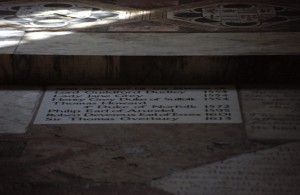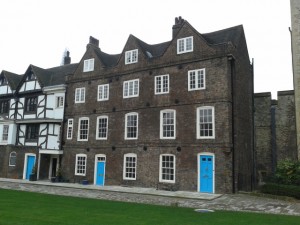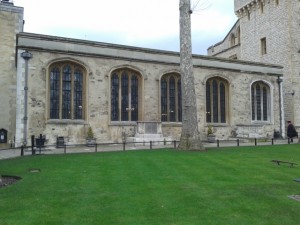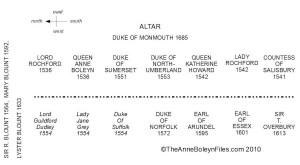This article originally appeared in the Tudor Society’s February 2015 edition of ‘Tudor Life Magazine’ as ‘Lady Jane Grey’s Death and Burial.’
February 12th marks the 461st anniversary of the execution of Lady Jane Dudley, who was Queen of England for nine days in 1553. There are various accounts of Jane’s death and burial and the anniversary of her execution is a fitting time to revisit these. This article looks at those featured in Richard Davey’s ‘The Nine Days’ Queen: Lady Jane Grey and Her Times.’
Published in 1909, the biography contained the only detailed, contemporary description of Queen Jane’s arrival at the Tower of London on 10th July 1553. Davey claimed that the description was written in a letter by Baptisa Spinola. The authenticity of this letter and its description of Jane have been questioned by historian Leanda de Lisle, since late 2009. De Lisle has concluded that the letter is a fake. (1)
Research into this letter and other claims made by Davey has also been conducted by Dr Stephan Edwards. He writes that, ‘Davey published his first version of the letter in 1906 in The Pageant of London.’ (2) Edwards describes how ‘Davey’s Nine Days’ Queen contains numerous other obvious fabrications to fill the documentary voids.’ (3) These include Jane’s christening gift from her maternal grandmother and details of how Frances Grey, Jane’s mother, is ‘described as dining daily in a solitary state.’ (4) Edwards points out that ‘Jane’s birth and christening are entirely undocumented’ (5) and that ‘there is absolutely no documentation surviving to detail the daily activities of the Grey household.’ (6)
Davey’s biography of Jane includes an account of her execution. He starts by describing a delay of an hour between Guildford’s execution (Jane’s husband) and her own. ‘ The direful procession which was to conduct a young and innocent Princess of the Blood Royal, of barely seventeen summers to the foot of an ignominious scaffold, was formed according to established precedent. But for some unexplained reason, it was nearly an hour late in starting from Patridge’s house to the place of execution.’ (7)
Davey suggests a reason for this. ‘The delay may have resulted from the state of nervous prostration into which the unfortunate Princess had been thrown by the sight of her husband’s mangled remains. It would have been impossible, even in those hard times, to convey the victim to execution if she had swooned.’ (8)
The first account of Jane’s execution in ‘The Chronicle of Queen Jane and Two Years of Queen Mary’ does not mention a delay before her execution. ‘The saide lady, being nothing at all abashed, neither with feare of her owne deathe, which then approached, neither with the sight of the ded carcase of hir husbande, when he was brought in to the chappell, came fourthe, the levetenaunt leding hir…’ (9) Davey himself did not mention any delay in his 1906 book, ‘The Pageant of London Vol II’, where he writes, ‘Almost immediately, after Guildford’s body had been taken into the chapel, the Lord Lieutenant brought forth the Lady Jane.’ (10)
Davey also describes the procession to the scaffold in great detail. ‘ First, came a company of two hundred Yeoman of the Guard; then, the executioner, in a tight-fitting scarlet worsted and cloth garment, displaying the swelling muscles of this chest, arms and legs; his face was masked, and his head hooded in scarlet. Beside him marched his assistant, a rough-looking man, who carried the axe over his shoulder; then Sir John Brydges, Lieutenant of the Tower, with Sir Thomas Brydges, Deputy-Lieutenant, and between them Sir John Gage, Constable of the Tower, with two Sheriffs, in their robes of office. Lastly, the young prisoner herself…On her right walked Abbot Feckenham, in his black robe, without a surplice, and carrying a crucifix in his hand. Behind him came the Chaplains attached to the Chapel Royal of the Tower. Lady Jane’s ladies, Mrs. Tylney and Mrs. Ellen, and Mrs Sarah; two other women and a man-servant, all in deep mourning, and weeping bitterly, closed the doleful procession.’ (11)
The author of the ‘Chronicle of Queen Jane etc’ describes a much smaller group accompanying Jane to the scaffold. He writes that Lady Jane ‘came fourthe, the levetenant leding hir, in the same gown wherein she was arranyed, hir countenance nothing abashed, neither her eyes anything moysted with teares, although her ij. Gentylwomen, mistress Elizabeth Tylney and mistress Eleyn, wonderfully wept…’ (12) There is no mention of two hundred yeoman of the Guard, the executioner, his assistant, the chaplains nor Dr Feckenham. There is the possibility that the eye witness left out other members of the group and only mentioned the two weeping gentlewomen to contrast with Jane’s composure. However, Davey gives a different description in the ‘Pageant of London vol II.’ ‘…the Lord Lieutenant brought forth the Lady Jane…The ‘fair innocent’ was assisted by Dr. Feckenham, the last Abbot of Westminster, by her two gentlewomen, Mrs. Elizabeth Tylney and Mrs. Helen, and by her old nurse, all of whom wept bitterly.’ (13)
Davey goes into greater detail about what Lady Jane was wearing at her execution, than was mentioned in a contemporary account. He describes how she was ‘dressed as on the occasion of her trial at the Guildhall in the same black cloth dress, edged with black velvet, a Marie Stuart cap of black velvet on her head, with a veil of black cloth hanging to the waist, and a white wimple concealing her throat; her sleeves edged with lawn, neatly plaited round the wrists. Not wearing chopines to increase her height, as on the occasion of her State entry into the Tower, the people who had not seen her since were greatly surprised at her diminutive stature.’ (14)
The author of the ‘Chronicle’ writes that Jane was ‘in the same gown wherein she was arranyed’ (15) and his earlier description of her leaving the Tower for trial at the Guildhall on 13 November 1553, gives the following details, ‘The lady Jane was in a blacke gowne of cloth, tourned downe; the cappe lyned with fese velvett, and edget about with the same, in a French hoode, all black, with a black byllyment…’ (16)
In his description, Davey refers to Jane not wearing her ‘chopines.’ (17) The only mention of Jane wearing ‘chopines’ is in the Spinola letter. The most we know of Jane in physical terms at her arrival at the Tower, from other contemporary accounts, is that the train of her gown was carried by her mother, the Duchess of Suffolk. (18)
As John Guy has pointed out, the contemporary description of Jane’s death in ‘The Chronicle of Queen Jane etc’ is made up of two different accounts. (19) The first ends with ‘wheron she praied all the way till she cam to the saide scaffolde, wheron when she was mounted, &….’ (20) And the second begins ‘First, when she mounted upon the scaffolde, she sayd to the people standing thereabout.’ (21)
Guy writes that ‘the original eyewitness description of Jane’s execution from the Chronicle was itself corrupted on first publication in 1850, when the text was expanded to incorporate the apocryphal material.’ (22) He continues, ‘this occurred because the editor of the Chronicle, the antiquary John Gough Nichols, arbitrarily decided that the extraneous account must have been written by the same chronicler.’ (23) Guy thinks that the second account, entitled ‘The Ende of the lady Jane Dudley, daughter of the duke of Suffolk, upon the scaffolde, at the houre of her death’ is ‘apocryphal’.(24)
Davey’s description portrays a vulnerable Jane when he adds details from a ‘little known report’ (25) by her supposed relative (Philippa de Clifford), to his description of Jane’s execution. He explains that ‘in the seventeenth and eighteenth centuries a sort of fashion was started in England, France, Belgium, Germany, and Italy for the writing of apocryphal memoirs of popular heroes and heroines: and as Lady Jane Grey was a great favourite of the Protestants, both at home and abroad, she has been the heroine of several of these volumes.’ (26) Davey adds in a footnote, ‘That the little volume exists there can be no doubt, as a copy of it was seen by the author at Brussels a few years ago’ (27) but does state that ‘its authenticity…must be taken with considerable caution.’ (28)
De Clifford’s account adds extra details between Jane’s scaffold speech and her reciting the Miserere. ‘After a pause, and wiping her eyes, she (Jane) said in a firmer voice, ‘Now, good people, Jane Dudley bids you all a long farewell. And may the Almighty preserve you from ever meeting the terrible death which awaits her in a few minutes. Farewell, farewell for ever more.’ (29)
In the second account of Jane’s execution in the ‘Chronicle’, there is no gap between the end of her speech and her prayers. ‘And now, good people, while I am alyve, I pray you to assyst me with your prayers.’ And then knelyng downe, she turned to Feckenham saying, “Shall I say this psalme?” (30)
Also, in the account ‘The Lady Jane’s Wordes upon the Scaffold’, part of a publication entitled ‘An Epistle of Ladye Jane, a righte virtuous Woman’ that appeared in 1554, there is no gap between the end of Jane’s speech and her saying the Miserere. ‘And I pray you al to beare me witnesse, that I here dye a true Christian woman, and that I truste to be saved by the bloud of Jesus Christ, and bi none other meanes; and now I pray you al, pray for me, and with me!” and so saied the Psalm of Miserere mei: that don, she saied, “Lorde save my soule, whyche now I commend into they hands:” and so prepared her selfe meekelie to the blocke.’ (31)
Lady Jane was buried in the Chapel St Peter ad Vincula, within the grounds of the Tower of London. Davey writes in a footnote that ‘Peter Derenzie states that ‘the corpse was interred in the Chapel-of-St.Peter-ad Vincula within the Tower, close by that of her husband, Lord Guildford Dudley, and between the decapitated bodies of Anne Boleyn and Katherine Howard, without any religious ceremony.’(32)
However, Chronicle writers, such as Stow and Weever make no mention of Jane’s burial place in the chapel and state that the Dukes of Northumberland and Somerset were buried between the two queens of Henry VIII. Stow wrote ‘Here lieth, before the high altar in St Peter’s church, two Dukes between two Queens, to wit, the Duke of Somerset and the Duke of Northumberland, between Queen Anne and Queen Katherine, all four beheaded.’ (33) Weever also wrote that, ‘Between the two Queens, before the high altar, lie buried two Dukes, the Duke of Somerset, Edward Seymour, and the Duke of Northumberland, John Dudley.’ (34)
The Chapel was renovated between 1876 and 1877 by order of Queen Victoria. In ‘Notices of the Historic Persons Buried in the Chapel of St. Peter Ad Vincula in the Tower of London ’, Doyne Courtenay Bell writes that ‘There is no record of their burial…(Jane, Guildford, Henry, Duke of Suffolk)… in any particular part of the chapel, but as they were persons of high birth and distinction, the chancel would naturally have been chosen, and commencing on the ‘dexter,’ or north side, they would have been interred.’ (35)
Originally it had not been planned to disturb those buried in the chancel but the pavement was discovered to be sinking and therefore during the renovation of the chancel, the remains found were removed and then reburied the top row under the decorative commemorative tiles that can be viewed today. (36) However, Bell notes that with ‘the lower group’ (37), ‘the original interments on this spot have been too much disturbed to admit of any satisfactory identifications of the remains.’ (38)
In his biography, Davey describes in great detail how Jane’s remains were discovered and reburied. He writes that: ‘Many years ago, a very small and broken coffin was discovered in this vault, containing the remains of a female of diminutive stature, with the head severed from the body. The skeleton, which crumbled to ashes immediately it was exposed to the effect of the atmosphere, was surmised to be that of Lady Jane Grey, and the dust was enclosed in an urn and placed immediately under the oval inscription in the chancel above, which records her death.’ (39)
There is no mention of any of this in the detailed report of the restoration, which states that ‘the recent examination of the chapel has failed to afford any means of identifying the spot.’ (40) This throws doubt on Davey’s claim. In the chapel today, there is a plaque on the floor of the chancel, which states ‘Near this spot lie the remains of Lord Guildford Dudley 1554, Lady Jane Grey 1554 etc.’ It lies below the commemorative tiles of the first row.

Plaque commemorating Jane, Guildford, Henry, Duke of Suffolk and others in St Peter ad Vincula.
(c) Lara Eakins
Dr Stephan Edwards writes that ‘repeated and unsupported fabrications reduce Nine Days’ Queen from the realm of biography to that of historical fiction.’ (41) This would seem to also be true regarding Davey’s account of Jane’s execution, where he weaves details from a contemporary account with those from the Spinola letter. And although he notes that Philippa de Clifford’s account of the execution, ‘must be taken with considerable caution’ (42), the very act of including it, further blurs the line between fact and fiction regarding what we know of Jane.
Sources
1.De Lisle, L. (2010), ‘Faking Jane’, BBC History Magazine, March.
De Lisle, L. (2010) The Sisters Who Would Be Queen: The Tragedy of Mary, Katherine and Lady Jane Grey, HarperPress, p.113
De Lisle, L. (2014), Tudor: The Family Story, Vintage, p.269-270
2.Edwards, S. Some Grey Matter – The Spinola Letter Date accessed: 20th October 2014
3.Ibid.
4.Ibid.
5.Ibid.
6.Ibid.
7.Davey, R. (1909) The Nine Days’ Queen: Lady Jane and Her Times, Methuen & Co, p.339
8.Ibid.
9.Nichols, J. G (ed) (1850) The Chronicle of Queen Jane and of Two Years of Queen Mary and Especially of the Rebellion of Sir Thomas Wyat, Written by a Resident in the Tower of London, Llanerch Publishers, p. 55-56
10.Davey, R. (1906) The Pageant of London Vol II A.D. 1500 to 1900, Methuen & Co, p. 95
11.Davey, R. (1909) The Nine Days’ Queen: Lady Jane and Her Times, Methuen & Co, p.340
12.Nichols, J. G (ed) (1850) The Chronicle of Queen Jane and of Two Years of Queen Mary and Especially of the Rebellion of Sir Thomas Wyat, Written by a Resident in the Tower of London, Llanerch Publishers, p. 56
13.Davey, R. (1906) The Pageant of London Vol II A.D. 1500 to 1900, Methuen & Co, p. 95
14.Davey, R. (1909) The Nine Days’ Queen: Lady Jane and Her Times, Methuen & Co, p.340
15.Nichols, J. G (ed) (1850) The Chronicle of Queen Jane and of Two Years of Queen Mary and Especially of the Rebellion of Sir Thomas Wyat, Written by a Resident in the Tower of London, Llanerch Publishers, p. 56
16.Nichols, J. G (ed) (1850) The Chronicle of Queen Jane and of Two Years of Queen Mary and Especially of the Rebellion of Sir Thomas Wyat, Written by a Resident in the Tower of London, Llanerch Publishers, p. 32
17.Davey, R. (1909) The Nine Days’ Queen: Lady Jane and Her Times, Methuen & Co, p.253
18.‘Spain: July 1553, 1-10′, Calendar of State Papers, Spain, Volume 11: 1553 (1916), pp. 69-80. URL: http://www.british-history.ac.uk/report.aspx?compid=88483 Date accessed: 08 July 2014
‘Spain: July 1553, 16-20′, Calendar of State Papers, Spain, Volume 11: 1553 (1916), pp. 90-109. URL: http://www.british-history.ac.uk/report.aspx?compid=88485 Date accessed: 05 July 2014 ‘Diary: 1553 (Jul – Dec)’, The Diary of Henry Machyn: Citizen and Merchant-Taylor of London (1550-1563) (1848), pp. 34-50. URL: http://www.british-history.ac.uk/report.aspx?compid=45512 Date accessed: 08 July 2014
19.Guy, J. (2010) The Story of Lady Jane Grey. In: Bann, S. & Whiteley, L. Painting History: Delaroche & Lady Jane Grey. National Gallery Company Ltd, p.14.
20.Nichols, J. G (ed) (1850) The Chronicle of Queen Jane and of Two Years of Queen Mary and Especially of the Rebellion of Sir Thomas Wyat, Written by a Resident in the Tower of London, Llanerch Publishers, p. 56
21.Ibid.
22.Guy, J. (2010) The Story of Lady Jane Grey. In: Bann, S. & Whiteley, L. Painting History: Delaroche & Lady Jane Grey. National Gallery Company Ltd, p.14.
23.Ibid.
24.Ibid.
25.Davey, R. (1909) The Nine Days’ Queen: Lady Jane and Her Times, Methuen & Co, p.342
26.Ibid.
27.Ibid
28.Ibid.
29.Davey, R. (1909) The Nine Days’ Queen: Lady Jane and Her Times, Methuen & Co, p.342-3
30.Nichols, J. G (ed) (1850) The Chronicle of Queen Jane and of Two Years of Queen Mary and Especially of the Rebellion of Sir Thomas Wyat, Written by a Resident in the Tower of London, Llanerch Publishers, p. 57
31.Oldys, W. (1809) The Harleian Miscellany. Volume III, John White & John Murray, p.119. Accessed via Google Books 30 December 2014
32.Davey, R. (1909) The Nine Days’ Queen: Lady Jane and Her Times, Methuen & Co, p.346
33.Bell, D.C. (1877) Notices of the Historic Persons Buried in the Chapel of St Peter ad Vincula in the Tower of London, John Murray, p.51
34.Ibid. p.51 & 53.
35.Ibid. p.53
36.Ibid. p.17
37.Ibid. p.54
38.Ibid.
39.Davey, R. (1909) The Nine Days’ Queen: Lady Jane and Her Times, Methuen & Co, p.346-347.
40.Bell, D.C. (1877) Notices of the Historic Persons Buried in the Chapel of St Peter ad Vincula in the Tower of London, John Murray, p.176
41.Edwards, S. Some Grey Matter – The Spinola Letter Date accessed: 20th October 2014
42.Davey, R. (1909) The Nine Days’ Queen: Lady Jane and Her Times, Methuen & Co, p.342




































